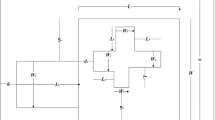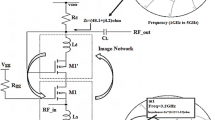Abstract
This research work investigates a CMOS based low noise amplifier (LNA) using differential active inductor with eight-shaped patch antenna for next generation wireless communication. The proposed work conceded into three different phases. The first phase proposes LNA architecture which includes multistage cascode amplifier with a gate inductor gain peaking technique. The ground approach for this architecture employs active inductor technique that includes two stages of differential amplifier. The proposed novel technique leads to give incremental in inductance by using of common mode feedback resistor and lowers the undesirable parasitic resistance effect. Additionally, this technique offers gain enhanced noise cancellation and achieves a frequency band of around 5.7 GHz. The proposed architecture includes single stage differential AI and enhances the bandwidth up to 6.8 GHz with peak gain of 21 dB at 7.8 GHz. The noise figure and stability factor are achieved which is reasonably good at 1 dB. The proposed architecture is design and optimized on advanced design RF simulator using 0.045 µm CMOS process technology. While in second phase, a narrow band eight-shaped patch antenna is designed which provides operating band range from 5.8 to 6.5 GHz with 6.2 GHz resonating frequency. Highest peak gain of 15 dB and maximum radiation power of 42.5 dBm is succeed by proposed antenna. The final phase provides integration strategy of LNA with antenna and achieves desired gain of nearly 21 dB with minimum NF of 1.2–1.5 dB in the same band.












Similar content being viewed by others
References
Bruccoleri, F., Klumperink, E. A. M., & Nauta, B. (2004). Wide-band CMOS low-noise amplifier exploiting thermal noise canceling. IEEE Journal of Solid-State Circuits, 39, 275–282.
Li, Q., Member, I. E. E. E., & Zhang, Y. (2007). A 1.5-V 2–9.6-GHz inductor less low-noise amplifier in 0.13 µm CMOS. IEEE Transactions on Microwave Theory and Techniques, 55, 2015–2023.
Ghadiri, A., & Moez, K. (2010). Gain-enhanced distributed amplifier using negative capacitance. IEEE Transactions on Circuits and Systems, 57, 2834–2843.
Sobhy, E., Helmy, A., Entesari, S., & Sánchez-Sinencio, E. (2011). A 2.8-mW Sub-2-dB noise-figure inductorless wideband CMOS LNA employing multiple feedback. IEEE Transactions on Microwave Theory and Techniques, 59, 3154–3161.
Yu, Y.-H., Yang, Y.-S., & Chen, Y.-J. (2010). A compact wideband CMOS low noise amplifier with gain flatness enhancement. IEEE Journal of Solid-State Circuits, 45, 502–508.
Moezzi, M., & Sharif Bakhtiar, M. (2012). Wideband LNA using active inductor with multiplefeed-forward noise reduction paths. IEEE Transactions on Microwave Theory and Techniques, 60, 1069–1077.
Ghadiri, A., & Moez, K. (2014). Wideband active inductor and negative capacitance for broadband RF and microwave applications. IEEE Transactions on Components, Packaging and Manufacturing Technology, 4, 1808–1814.
Ma, L., Wang, Z.-G., Jian, X., & Amin, N. M. (2017). A high linearity wideband common-gate LNA with differential active inductor. IEEE Transactions on Circuits and Systems II. https://doi.org/10.1109/tcsii.2016.2572201.
Reja, M. M., Moez, K., & Filanovsky, I. (2010). An area-efficient multistage 3.0 to 8.5 GHz CMOS UWB LNA using tunable active inductors. IEEE Transactions on Circuits Systems II, 57, 587–591.
Abdalla, M., Eleftheriades, G. V., & Phang, K. (2006). A differential 0.13 µm CMOS active inductor for high-frequency phase shifters. In Proceedings of IEEE international symposium on circuits systems (ISCAS) (pp. 3341–3344).
Akbari-Dilmaghani, R., Payne, A., & Toumazou, C. (1998). A high Q RF CMOS differential active inductor. In IEEE Proceedings ISCAS (Vol. 3, pp. 157–160).
Acknowledgements
This work was supported by the Inje University Grant 2018.
Author information
Authors and Affiliations
Corresponding author
Additional information
Publisher's Note
Springer Nature remains neutral with regard to jurisdictional claims in published maps and institutional affiliations.
Rights and permissions
About this article
Cite this article
Roy, G.M., Kanuajia, B.K., Dwari, S. et al. Investigation of CMOS Based Integration Approach Using DAI Technique for Next Generation Wireless Networks. Wireless Pers Commun 104, 1091–1107 (2019). https://doi.org/10.1007/s11277-018-6069-7
Published:
Issue Date:
DOI: https://doi.org/10.1007/s11277-018-6069-7




